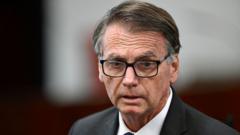The polls have officially closed in Canada, marking a pivotal moment as voters select their leaders amid an atmosphere charged with both urgency and change. The election, which many anticipated would favor the Conservative Party, has seen a surprising shift towards the Liberal Party, greatly influenced by the recent tenure of Prime Minister Mark Carney and President Trump's trade threats.
**Canada's Election Day: Polls Close as Voters Face Critical Choices Amid Turmoil**

**Canada's Election Day: Polls Close as Voters Face Critical Choices Amid Turmoil**
As Canada's federal election unfolds, voters grapple with choices reflecting their reactions to international pressures and domestic concerns, with results expected into Monday night.
The latest preliminary results, as reported by Elections Canada, indicate that the Liberal Party, under Carney's leadership, has a slight edge with approximately 50.3% of the vote compared to the Conservative Party’s 43.1%. The New Democratic Party (NDP) and Green Party trail significantly, implying a critical two-horse race dominating the political landscape.
Just three months prior, the Conservative Party commanded a vast lead in the polls, but the political landscape shifted dramatically following Prime Minister Justin Trudeau's resignation amidst growing discontent with his party’s policies. The Conservative leader, Pierre Poilievre, faces scrutiny not only regarding his campaign promises but also due to his resemblance in rhetoric to Trump, which has left some voters wary.
Election day dynamics also showcase the effects of a record advance poll turnout, with over 7.3 million Canadians casting their votes early, reflecting rising civic engagement. Each party now focuses on crucial electorates scattered across the diverse ridings in Canada, where results will trickle in gradually as votes in various time zones are counted.
As voters head to the polls following discussions surrounding pressing issues such as immigration and economic policy, they will ultimately determine which leader will steer Canada into the next chapter at a time of global economic uncertainty.
**In Summary:**
- Polling across Canada has concluded, with the outcome of the federal election set to reflect a significant realignment in political support.
- The Liberal Party, led by new Prime Minister Mark Carney, currently shows a slim lead over the Conservative Party, which had previously maintained a strong advantage.
- Canadians are experiencing a surge of electoral engagement with a notable advance voting turnout, impacting the dynamic of the election.
- Political and global challenges, particularly the influence of American leadership, shape the narrative and decisions at the ballot box.
Just three months prior, the Conservative Party commanded a vast lead in the polls, but the political landscape shifted dramatically following Prime Minister Justin Trudeau's resignation amidst growing discontent with his party’s policies. The Conservative leader, Pierre Poilievre, faces scrutiny not only regarding his campaign promises but also due to his resemblance in rhetoric to Trump, which has left some voters wary.
Election day dynamics also showcase the effects of a record advance poll turnout, with over 7.3 million Canadians casting their votes early, reflecting rising civic engagement. Each party now focuses on crucial electorates scattered across the diverse ridings in Canada, where results will trickle in gradually as votes in various time zones are counted.
As voters head to the polls following discussions surrounding pressing issues such as immigration and economic policy, they will ultimately determine which leader will steer Canada into the next chapter at a time of global economic uncertainty.
**In Summary:**
- Polling across Canada has concluded, with the outcome of the federal election set to reflect a significant realignment in political support.
- The Liberal Party, led by new Prime Minister Mark Carney, currently shows a slim lead over the Conservative Party, which had previously maintained a strong advantage.
- Canadians are experiencing a surge of electoral engagement with a notable advance voting turnout, impacting the dynamic of the election.
- Political and global challenges, particularly the influence of American leadership, shape the narrative and decisions at the ballot box.






















